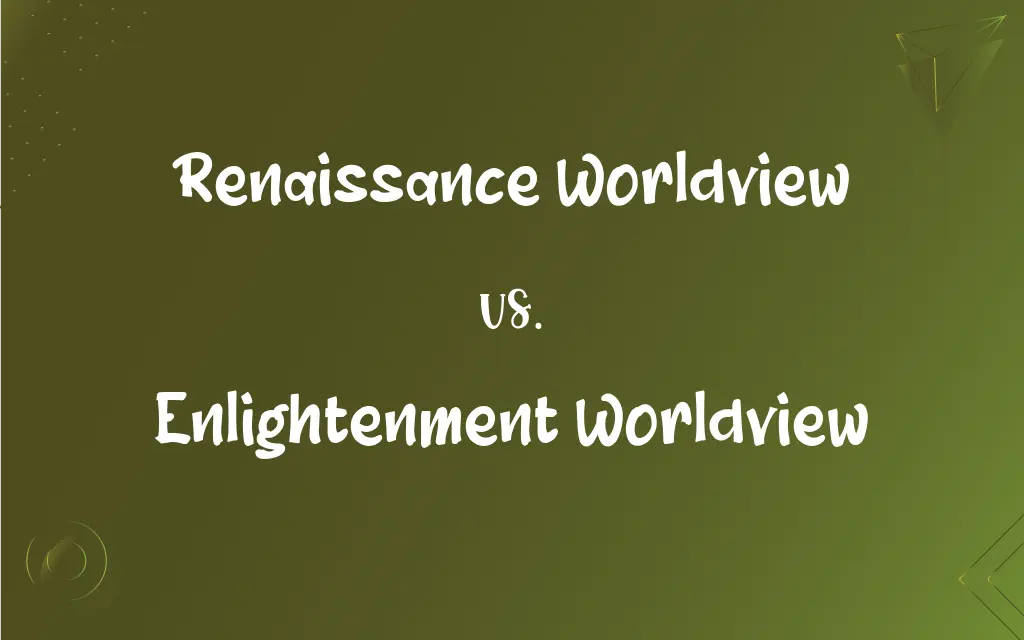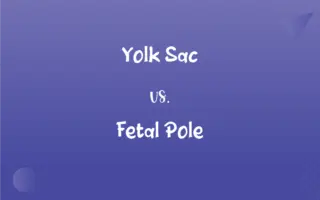Renaissance Worldview vs. Enlightenment Worldview: What's the Difference?
Edited by Aimie Carlson || By Janet White || Published on March 29, 2024
The Renaissance worldview emphasized humanism and the revival of classical learning, while the Enlightenment worldview focused on reason, science, and the questioning of traditional authority.

Key Differences
The Renaissance worldview was characterized by a renewed interest in the art, literature, and philosophies of ancient Greece and Rome, emphasizing human potential and achievements. It was a period of rediscovery of classical thought, coupled with a focus on humanism, where the individual and human experience took center stage. The Enlightenment worldview, on the other hand, emerged as a movement that prioritized reason, empirical evidence, and scientific method over tradition and religious dogma. It advocated for the use of reason in understanding and improving the world.
Renaissance thinkers looked back to the classical age for inspiration, seeking to blend ancient wisdom with contemporary culture. This period saw the flourishing of arts and literature, with a focus on beauty, proportion, and human emotion. Enlightenment thinkers, however, looked forward, believing in progress and the power of human reason to solve societal problems. This era is marked by advancements in science, philosophy, and political thought, emphasizing individual liberty and skepticism towards unproven beliefs.
The Renaissance worldview celebrated the individual’s role in the creative process, highlighting personal achievement and the potential for human greatness. It fostered an environment where artists and scholars could thrive, often supported by patrons such as the Medici family in Florence. The Enlightenment worldview, by contrast, focused on collective human progress through education, political reform, and the questioning of authority. It led to significant societal changes, including the American and French revolutions.
In the Renaissance, there was a strong focus on rediscovering and studying classical texts, which led to a revival of learning known as humanism. This intellectual movement placed a high value on human interests, capabilities, and dignity. The Enlightenment expanded on humanist ideals by advocating for the rights of the individual and the separation of church and state, promoting freedom of thought and expression.
The Renaissance and the Enlightenment both sought to illuminate the human condition, but they did so through different lenses. The Renaissance was a celebration of human achievement in the arts and humanities, grounded in a rediscovery of the classical past. The Enlightenment was a rational and scientific examination of the world and society, emphasizing the role of reason in human affairs and the importance of questioning established norms.
ADVERTISEMENT
Comparison Chart
Focus
Revival of classical learning and humanism.
Reason, science, and skepticism of authority.
Inspirational Era
Ancient Greece and Rome.
Forward-looking, towards progress and reform.
Key Themes
Human potential, arts, and individual achievement.
Rationalism, individual rights, and scientific advancement.
Impact on Society
Cultural flourishing in arts and literature.
Political and social reforms, rise of democracy.
View on Authority
Patrons and tradition influenced artistic expression.
Questioned traditional authority, promoting liberty and democracy.
ADVERTISEMENT
Renaissance Worldview and Enlightenment Worldview Definitions
Renaissance Worldview
Exploration and discovery marked by curiosity about the world.
The spirit of exploration in the Renaissance worldview led to significant advancements in geography and science.
Enlightenment Worldview
Advocacy for individual rights and freedoms against absolutism.
Central to the Enlightenment worldview was the belief in the inherent rights of individuals.
Renaissance Worldview
Integration of art, science, and philosophy based on ancient traditions.
The Renaissance worldview sought harmony between scientific inquiry and artistic expression.
Enlightenment Worldview
Promotion of democracy and the questioning of traditional authority.
The Enlightenment worldview inspired political revolutions with its critique of monarchy and tyranny.
Renaissance Worldview
Patronage system supporting artists, contributing to cultural achievements.
Under the Renaissance worldview, patrons like the Medici family fostered unprecedented artistic production.
Enlightenment Worldview
Belief in progress and the potential for societal improvement.
The Enlightenment worldview held that through reason, society could achieve continuous progress.
Renaissance Worldview
A rebirth of classical art and learning emphasizing human potential.
The Renaissance worldview celebrated the individual artist's ability to create beauty.
Enlightenment Worldview
Scientific revolution and skepticism towards superstition.
The scientific advancements of the Enlightenment worldview diminished the influence of superstition.
Renaissance Worldview
Focus on humanism, highlighting the dignity and worth of the individual.
Humanism, central to the Renaissance worldview, underscored the study of classical texts.
Enlightenment Worldview
Emphasis on reason and empirical evidence over tradition.
The Enlightenment worldview championed the use of reason to question established beliefs.
FAQs
What is the Enlightenment worldview?
Emphasizes reason, science, and questioning of traditional authority.
How did the Renaissance and Enlightenment worldviews impact art?
Renaissance art focused on beauty and human emotion; Enlightenment art reflected themes of reason and political change.
What role did science play in both worldviews?
In the Renaissance, science began integrating with the arts; in the Enlightenment, it became central to understanding the world.
How did political thought evolve from the Renaissance to the Enlightenment?
From focusing on the role of individuals in society to advocating for democracy and individual rights.
How did each worldview approach human potential?
The Renaissance celebrated individual achievement; the Enlightenment focused on collective human progress.
What defines the Renaissance worldview?
A focus on humanism, classical learning, and the arts.
How did the concept of individual rights evolve from the Renaissance to the Enlightenment?
From emphasizing the dignity of the individual to advocating for legal rights and freedoms.
What was the relationship with the classical past in each worldview?
The Renaissance sought to revive it; the Enlightenment built upon it for future progress.
What were the key philosophical differences between the two worldviews?
Renaissance philosophy was human-centric; Enlightenment philosophy was reason-centric.
How did the Enlightenment worldview influence modern democracy?
It laid the groundwork for democratic principles and institutions.
What impact did the Renaissance worldview have on education?
It led to a broader curriculum that included the arts and humanities.
What role did skepticism play in the Enlightenment worldview?
It was a tool for challenging outdated traditions and beliefs.
What role did religion play in each worldview?
The Renaissance harmonized religion with humanism; the Enlightenment promoted secularism.
How did Enlightenment thinkers view progress?
As an inevitable outcome of the application of reason and science.
What legacy did the Renaissance and Enlightenment worldviews leave for modern society?
A rich cultural heritage and the foundations of modern science, political thought, and education.
What was the significance of exploration in the Renaissance worldview?
It reflected a curiosity and desire to understand the world beyond Europe.
How did each worldview influence the social hierarchy?
The Renaissance reinforced it through patronage; the Enlightenment questioned it through advocacy for equality.
How did education systems change from the Renaissance to the Enlightenment?
From classical studies to include scientific and rational thought.
How did each worldview view authority and governance?
The Renaissance generally accepted existing hierarchies; the Enlightenment challenged them.
What were the artistic contributions of the Renaissance compared to the Enlightenment?
The Renaissance produced masterpieces in visual arts; the Enlightenment influenced literature and political writing.
About Author
Written by
Janet WhiteJanet White has been an esteemed writer and blogger for Difference Wiki. Holding a Master's degree in Science and Medical Journalism from the prestigious Boston University, she has consistently demonstrated her expertise and passion for her field. When she's not immersed in her work, Janet relishes her time exercising, delving into a good book, and cherishing moments with friends and family.
Edited by
Aimie CarlsonAimie Carlson, holding a master's degree in English literature, is a fervent English language enthusiast. She lends her writing talents to Difference Wiki, a prominent website that specializes in comparisons, offering readers insightful analyses that both captivate and inform.































































